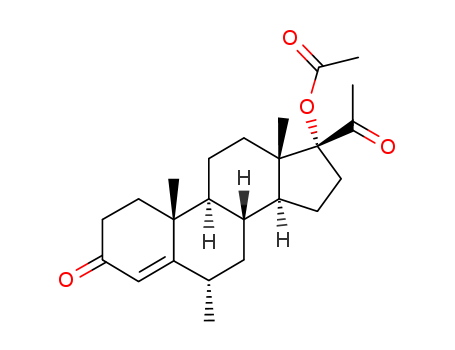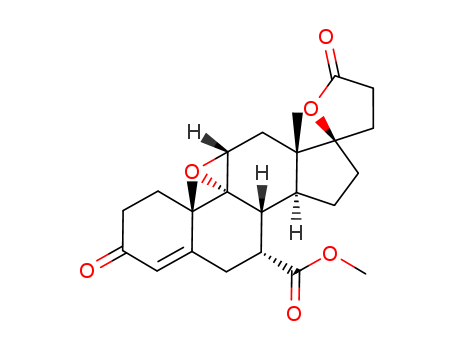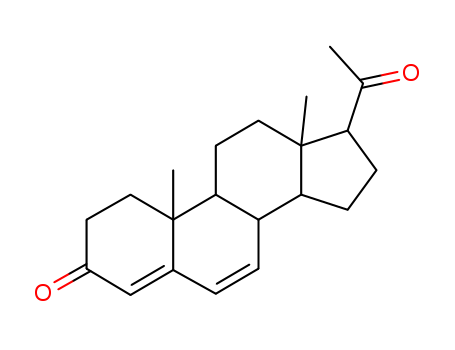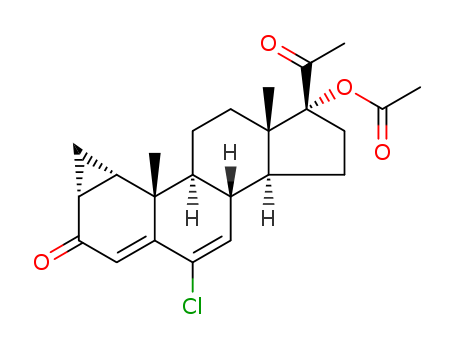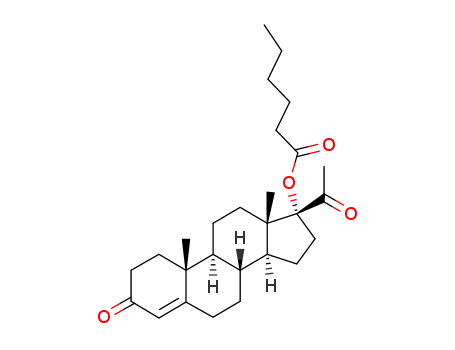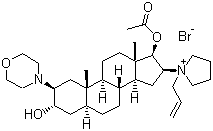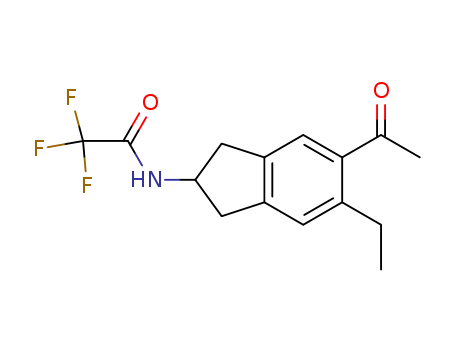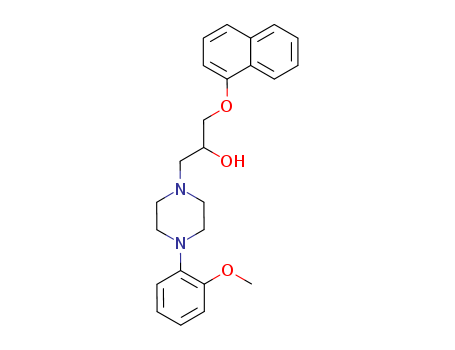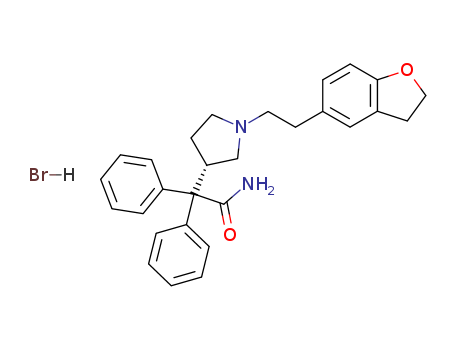
133099-07-7
- Product Name:Darifenacin Hydrobromide
- Molecular Formula:C28H30N2O2.HBr
- Purity:99%
- Molecular Weight:507.47
Product Details;
CasNo: 133099-07-7
Molecular Formula: C28H30N2O2.HBr
Chinese Manufacturer Supply Wholesale Darifenacin Hydrobromide 133099-07-7 Cheap Price
- Molecular Formula:C28H30N2O2.HBr
- Molecular Weight:507.47
- Vapor Pressure:1.11E-16mmHg at 25°C
- Melting Point:228-230 °C
- Boiling Point:614.3 °C at 760 mmHg
- Flash Point:325.3 °C
- PSA:41.57000
- LogP:5.94630
Darifenacin hydrobromide(Cas 133099-07-7) Usage
|
Description |
Darifenacin, an orally active, once a day selective M3 receptor antagonist, was launched for the treatment of overactive bladder in patients with symptoms of urge urinary incontinence, urgency and frequency. The drug selectively inhibits M3 receptor in the detrusor muscle while sparing the M1 and M2 receptors that are believed to be involved in central nervous system and cardiovascular function respectively. The compound was originally developed by Pfizer and licensed to Novartis and Bayer. |
|
Chemical Properties |
White Solid |
|
Uses |
Darifenacin hydrobromide is used as a medication to treat urinary incontinence. It works by blocking the M3 muscarinic acetylcholine receptor. |
|
Definition |
ChEBI: The hydrobromide salt of darifenacin. A selective antagonist for the M3 muscarinic acetylcholine receptor, which is primarily responsible for bladder muscle contractions, it is used in the management of urinary incontinence. |
|
Brand name |
Enablex (Novartis). |
|
General Description |
Darfenacin (Enablex),(s)-2-{1-[2-(2,3-dihydrobenzofuran-5-yl)ethyl]-3-pyrrolidinyl}-2,2-diphen-ylacetamide, is an antimuscarinicagent that has selectivity for the M3 muscarinicsubtype receptor. By competitively blocking of the muscarinicreceptors results in a reduction of the smoothmuscle tone, allowing for greater volume of urine to bestored in the bladder. This results in less urinary incontinence,urgency, and frequency. It is a white to almostwhite, crystalline powder, with a molecular weight of507.5. Darifenacin is metabolized by the isozymesCYP2D6 and CYP3A4 with the primary metabolic routesbeing monohydroxylation of the dihydrobenzofuran ring,opening of the dihydrobenzofuran ring, and N-dealkylationof the pyrrolidine nitrogen. |
|
Biochem/physiol Actions |
Darifenacin hydrobromide is an antispasmodic muscarinic antagonist, selective for blocking the M3 muscarinic acetylcholine receptor, which is primarily responsible for bladder muscle contractions. Darifenacin hydrobromide has 9 and 12-fold greater affinity for M3 compared to M1 and M5, respectively, and 59-fold greater affinity for M3 compared to both M2 and M4. Darifenacin is used clinically to treat urinary incontinence and overactive bladder syndrome. |
|
Synthesis |
The synthesis of darifenacin is depicted in Scheme 5. Commercially available (2S,4R)-(-)-4-hydroxy-2-pyrrolidinecarboxylic acid (17), anhydrous cyclohexanol and 2-cyclohexen-1-one were heated at 154oC to give de-carboxylated compound 18 in 69 % yield. The 3-(R)-hydroxypyrrolidine (18) was N-tosylated with p-toluenesulfonyl chloride in pyridine yielding compound 19 in 26 % yield . The N-tosylated alcohol 19 was subjected to Mitsunobu reaction in the presence of methyl ptoluenesulfonate, triphenylphosphine and diethyl azodicarboxylate (DEAD) in THF to afford N-tosyl-3(S)-(tosyloxy) pyrrolidine (20) in 70% yield, which was then condensed with 2,2-diphenylacetonitrile with NaH in refluxing toluene to give 2,2-diphenyl-2-[1-(p-toluenesulfonyloxy)pyrrolidin- 2(S)-yl]acetonitrile (21). The tosyl group of 21 was removed with 48% HBr and phenol in refluxing water to yield 2,2- diphenyl-2-[2(S)-pyrrolidinyl] acetonitrile as its corresponding hydrogen bromide salt (22), which was coupled to 2-(2, 3-dihydrobenzofuran-5-yl) acetic acid (23) by treatment with carbonyldiimidazole (CDI) in ethyl acetate to the corresponding amide 24 in a quantitative yield. The amide (24) was dissolved in toluene and reduced with sodium borohydride in THF with slow addition of boron trifluoride THF complex to keep the temperature below 10°C to give free amine in 88% yield. The free amine was converted to corresponding hydrogen bromide salt (25) with 48% HBr in methanol. Compound 25 was hydrolyzed with potassium hydroxide in refluxing 2-methyl-butan-2-ol for twenty hours to give acetamide which was crystallized from toluene as a toluene solvated form in 84% yield. Finally, the toluene solvated compound was converted to darfenacin hydrobromide (IV) with 48% HBr in 2-methyl-butan-2-ol. |
|
references |
[1]. hegde ss1,choppin a,bonhaus d,briaud s,loeb m,moy tm,loury d,eglen rm.functional role of m2 andm3muscarinic receptorsin the urinary bladder of rats in vitro and in vivo.br j pharmacol.1997 apr;120(8):1409-18.[2]. brann mr1,ellis j,jrgensen h,hill-eubanks d,jones sv. muscarinicacetylcholinereceptorsubtypes: localization and structure/function.prog brain res.1993;98:121-7.[3]. miller dw1,hinton m,chen f.evaluation of drug efflux transporter liabilities of darifenacin in cell culture models of the blood-brain and blood-ocular barriers. neurourol urodyn.2011 nov;30(8):1633-8. doi: 10.1002/nau.21110. epub 2011 aug 8.[4]. haab f1,stewart l,dwyer p.darifenacin, anm3selectivereceptorantagonist, is an effective and well-tolerated once-daily treatment for overactive bladder. eur urol.2004 apr;45(4):420-9; discussion 429. |
InChI:InChI=1/C28H30N2O2.BrH/c29-27(31)28(23-7-3-1-4-8-23,24-9-5-2-6-10-24)25-14-17-30(20-25)16-13-21-11-12-26-22(19-21)15-18-32-26;/h1-12,19,25H,13-18,20H2,(H2,29,31);1H
133099-07-7 Relevant articles
Synthesis/Isolation of darifenacin hydrobromide by-products
Vasantha,Lakshmanarao,Srinivasa Rao,Sivalakshmi Devi,Venkata Suryanarayana
, p. 824 - 828 (2013/07/26)
During the process development in the la...
A new solvent system (Cyclopentyl methyl ether-water) in process development of darifenacin HBr
Pramanik, Chinmoy,Bapat, Kiran,Chaudhari, Ashok,Tripathy, Narendra K.,Gurjar, Mukund K.
, p. 1591 - 1597 (2013/02/23)
Darifenacin is a potent and competitive ...
AN IMPROVED PROCESS FOR THE PREPARATION OF DARIFENACIN HYDROBROMIDE
-
Page/Page column 12-15, (2011/06/26)
The present invention relates to an impr...
Novel Polymorphs of Darifenacin Free Base and its Hydrobromide Salt
-
Page/Page column 7, (2010/08/18)
The present invention provides a novel a...
133099-07-7 Process route
-
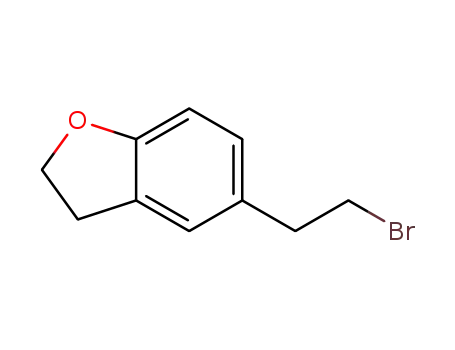
-
127264-14-6
2,3-dihydro-5-(2-bromoethyl)benzofuran

-
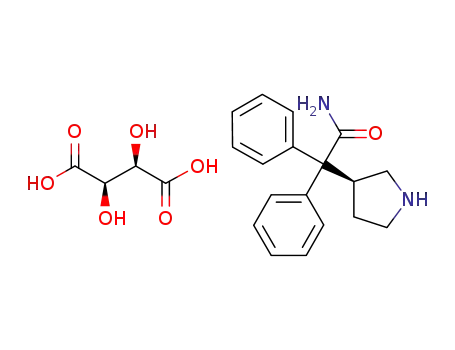
-
134002-26-9
(S)-2,2-diphenyl-2-(pyrrolidin-3-yl)-acetamide L-tartrate

-
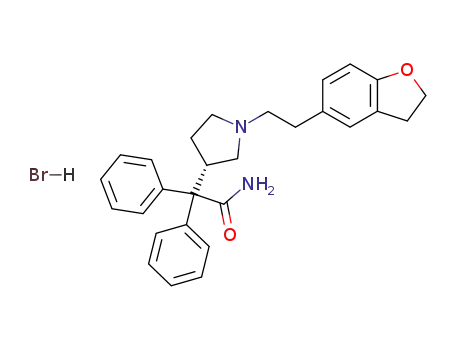
-
133099-07-7
(S)-darifenacin hydrobromide
| Conditions | Yield |
|---|---|
|
2,3-dihydro-5-(2-bromoethyl)benzofuran; (S)-2,2-diphenyl-2-(pyrrolidin-3-yl)-acetamide L-tartrate;
With
potassium hydroxide;
triethylmethylammonium chloride;
In
water; toluene;
at 100 ℃;
for 15.25h;
With
hydrogen bromide;
In
water; toluene;
Product distribution / selectivity;
|
93.2% |
|
(S)-2,2-diphenyl-2-(pyrrolidin-3-yl)-acetamide L-tartrate;
With
potassium hydroxide;
triethylmethylammonium chloride;
In
2-methyltetrahydrofuran; water;
at 60 - 70 ℃;
2,3-dihydro-5-(2-bromoethyl)benzofuran;
In
2-methyltetrahydrofuran; water;
for 16h;
Heating / reflux;
With
hydrogen bromide;
In
2-methyltetrahydrofuran; water;
at 0 - 20 ℃;
for 2h;
Product distribution / selectivity;
|
90.67% |
|
2,3-dihydro-5-(2-bromoethyl)benzofuran; (S)-2,2-diphenyl-2-(pyrrolidin-3-yl)-acetamide L-tartrate;
With
potassium hydroxide;
triethylmethylammonium chloride;
In
water; butanone;
at 75 ℃;
for 6h;
With
hydrogen bromide;
In
water; butanone;
at 0 - 5 ℃;
for 2h;
Product distribution / selectivity;
|
84.92% |
|
2,3-dihydro-5-(2-bromoethyl)benzofuran; (S)-2,2-diphenyl-2-(pyrrolidin-3-yl)-acetamide L-tartrate;
With
potassium hydroxide;
triethylmethylammonium chloride;
In
toluene;
at 100 ℃;
for 16.25h;
With
hydrogen bromide;
In
water; toluene;
Product distribution / selectivity;
|
76.3% |
|
2,3-dihydro-5-(2-bromoethyl)benzofuran; (S)-2,2-diphenyl-2-(pyrrolidin-3-yl)-acetamide L-tartrate;
With
potassium carbonate;
In
acetonitrile;
at 25 - 70 ℃;
Inert atmosphere;
With
hydrogen bromide;
In
dichloromethane; water;
at 5 - 30 ℃;
pH=2 - 9;
|
|
|
Multi-step reaction with 2 steps
1.1: potassium carbonate / water / 0.5 h / 25 - 30 °C
1.2: 12 h / 25 - 75 °C
2.1: hydrogen bromide / water; acetone / 7 h / 0 - 20 °C
With
hydrogen bromide; potassium carbonate;
In
water; acetone;
|
-

-
127264-14-6
2,3-dihydro-5-(2-bromoethyl)benzofuran

-

-
133099-07-7
(S)-darifenacin hydrobromide
| Conditions | Yield |
|---|---|
|
Multi-step reaction with 2 steps
1: potassium hydroxide / acetonitrile / 18 h / 40 - 50 °C
2: hydrogen bromide / water; acetone / 2.25 - 12 h / 0 - 30 °C
With
potassium hydroxide; hydrogen bromide;
In
water; acetone; acetonitrile;
|
|
|
Multi-step reaction with 3 steps
1: potassium carbonate / acetonitrile
2: ammonia / methanol / 5 - 7 h / 28 - 45 °C
3: hydrogen bromide / water; acetone / 2.25 - 12 h / 0 - 30 °C
With
ammonia; hydrogen bromide; potassium carbonate;
In
methanol; water; acetone; acetonitrile;
|
133099-07-7 Upstream products
-
127264-14-6

2,3-dihydro-5-(2-bromoethyl)benzofuran
-
134002-26-9

(S)-2,2-diphenyl-2-(pyrrolidin-3-yl)-acetamide L-tartrate
-
943034-50-2
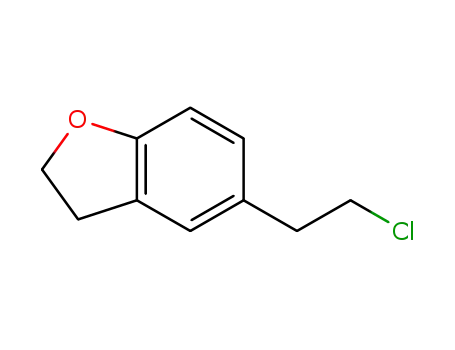
2-(2,3-dihydrobenzofuran-5-yl)ethylchloride
-
134002-25-8
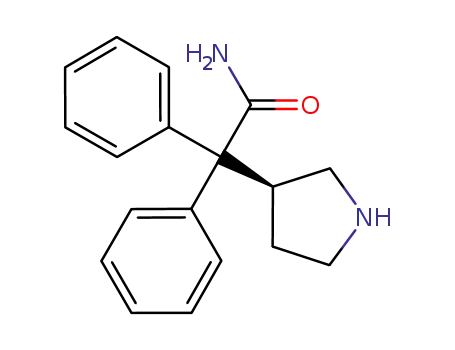
2,2-diphenyl-2-[(3S)-pyrrolidin-3-yl]acetamide
133099-07-7 Downstream products
-
133099-04-4
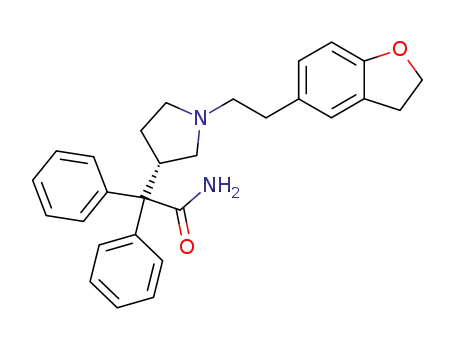
darifenacin
Relevant Products
-
Rocuronium bromide
CAS:119302-91-9
-
Naftopidil
CAS:57149-07-2

